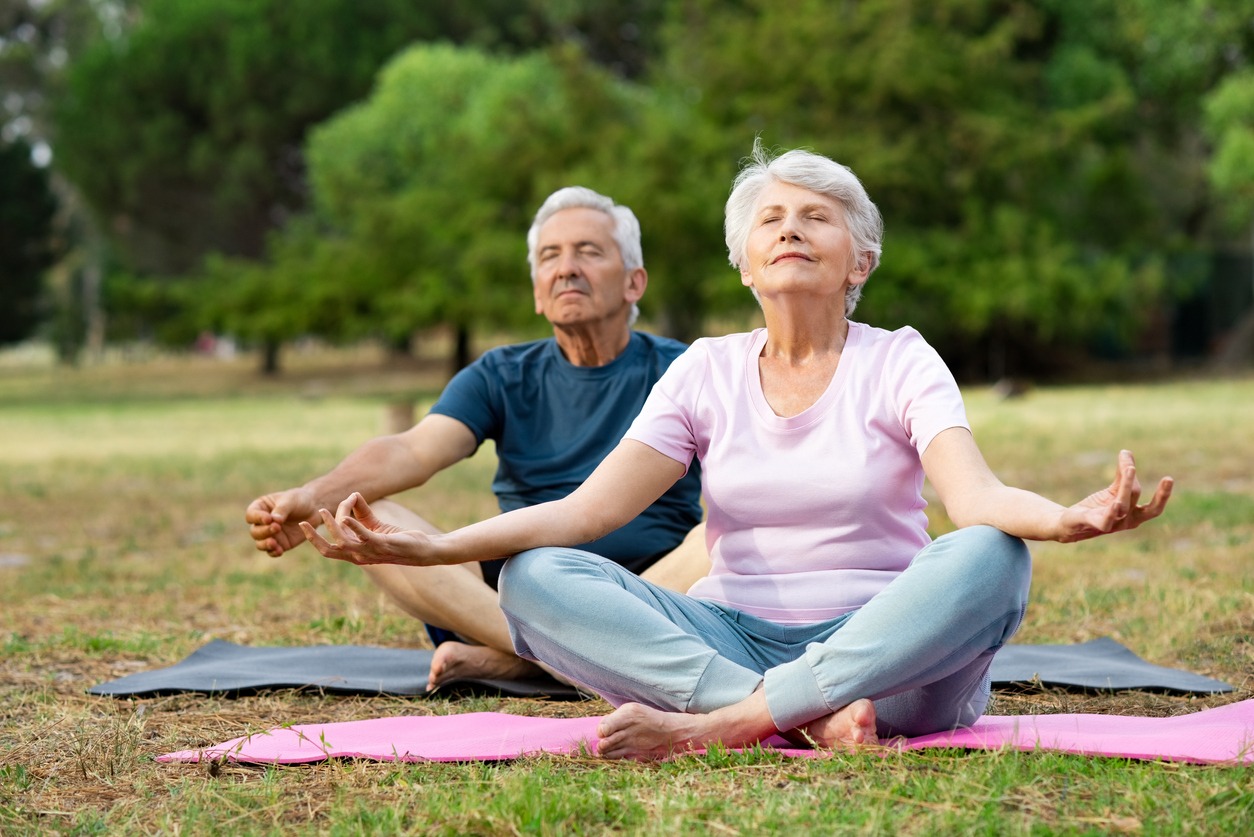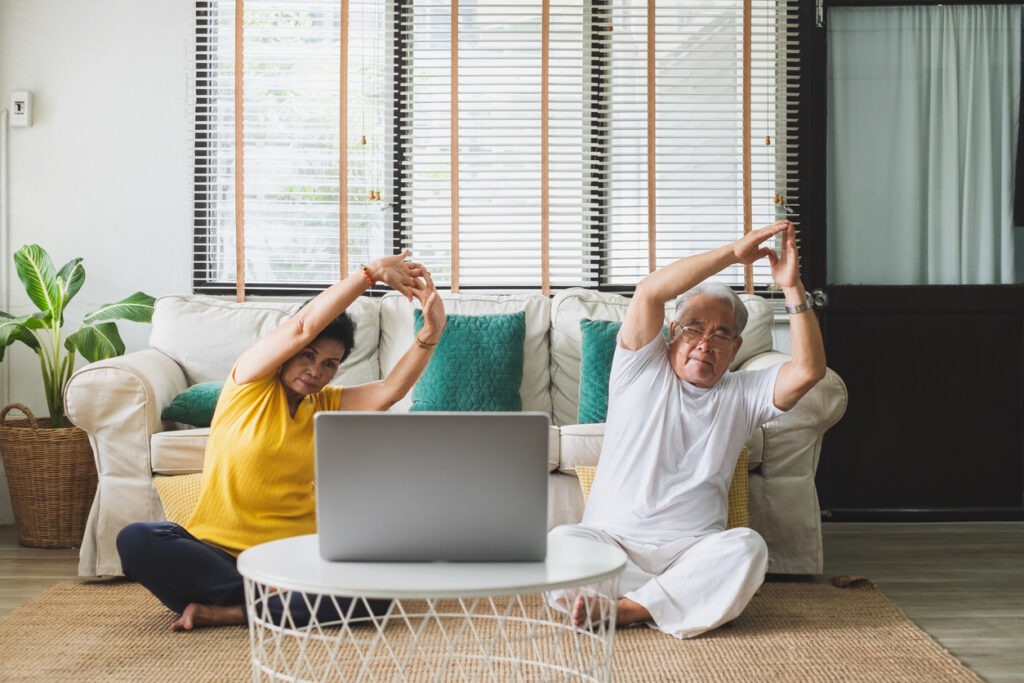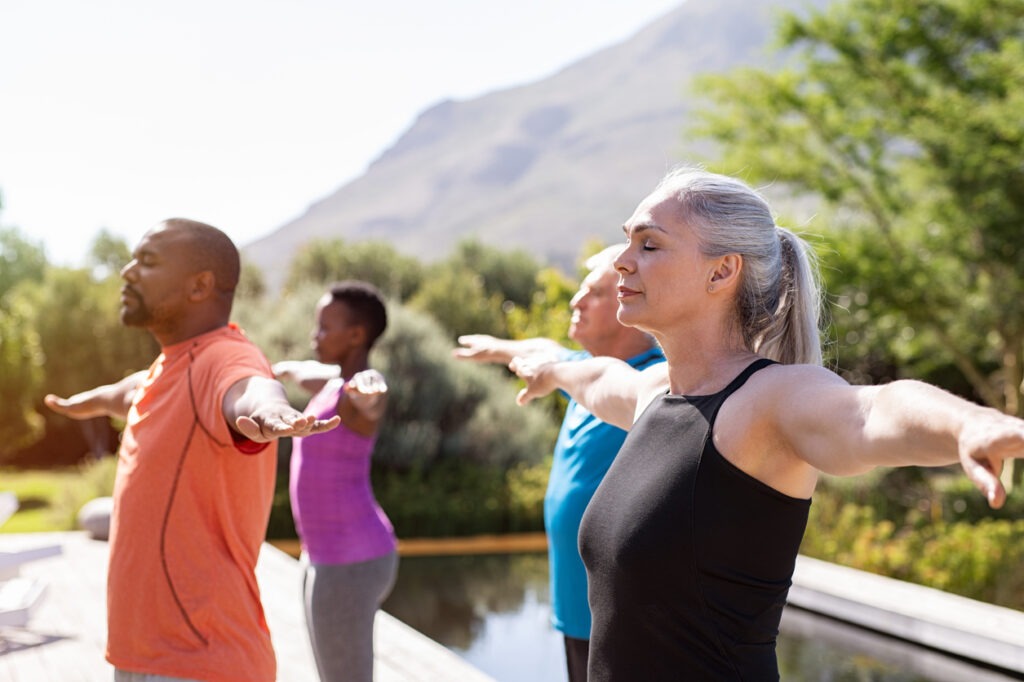We know that staying active even in advanced age is necessary to help maintain a healthy lifestyle. Risk of life-threatening diseases like cardiovascular diseases, diabetes, and certain types of cancers. With regular exercise, seniors can feel more energetic and help manage the pains and aches that come with aging. Exercise and physical health are important, but the risk of strain and joint pain is real in older adults who are trying to stay active and flexible.
Thankfully, there are low-impact fitness options that offer amazing health benefits, like yoga. When practiced correctly, it can have substantial benefits for seniors.
What is Yoga?
Yoga is a physical, mental, and spiritual discipline that involves poses, exercise, meditation, and control of breathing and emotions. Rooted in Indian philosophy, yoga began as a spiritual practice, but it has now become a popular way of promoting physical and mental well-being.
Some seniors may think of yoga as a New Age practice geared toward younger women, but it has increasingly become an option for improving older adults’ health. Safe and gentle yoga practice can be highly beneficial for adults.
Yoga might be a fun and easy practice even if you’re not enthusiastic about conventional exercise. You can do it sitting down if you need to, which is a great option for the elderly. Yoga has long been known as a gentle yet excellent way to achieve improved breathing, balance, flexibility, and strength.
Some yoga poses might be too advanced for seniors, but the beauty of this practice is that poses can be easily adapted to suit beginners and people with limited mobility.
Why Yoga for Seniors?
We all know the importance of staying as fit as we can while aging. Yoga for the elderly and seniors is an ideal way to accomplish this – you can modify it according to your needs and limitations. If you are also going through something stressful, even traumatic, yoga has the added benefit of being calming and relaxing.
Yoga is a great choice for seniors who want to improve their overall health. While there are yoga practices that require strenuous stretching and a wide range of movements, there are yoga poses and practices that are suitable for people who have pre-existing joint conditions and other pain issues.
Yoga can be excellent for seniors who want to retain their physical flexibility and get the healing benefits of this exercise. However, this doesn’t mean that anyone can look up a bunch of yoga exercises to do – you need an instructor to learn correctly. If you’re looking towards yoga for seniors, it’s even more important to have proper guidance. Always take it slow if you have a pre-existing condition.
Benefits of Yoga for Seniors
Yoga, especially restorative yoga, offers a wide array of health benefits for seniors. The practice can improve both physical and psychological aspects of health. Seniors who often struggle with pain, imbalance, joint stress, osteoarthritis, and other physical limitations can benefit from doing yoga and incorporating it into their daily routine.
Here are some of the benefits of practicing yoga for seniors:
Better balance and stability
Balance and stability often decrease with age, causing seniors to be at risk of falling more, even when doing regular, everyday activities. Strengthening the muscles and improving balance prevent the likelihood of falls, which is a common concern among the elderly.
The good news is that many yoga poses focus on stability and balance and help prevent falls by strengthening the core muscles that help keep the body stable. Practicing yoga every day can help you become steadier on your feet and reduce the incidents of falls.
Improves flexibility and joint health
If you’re looking for gentle exercise to increase your flexibility, yoga is a great option. It’s perfect for seniors who want to stay active without the strain associated with high-intensity cardio and strength training. Low-impact exercises like yoga can help seniors build joint flexibility and muscle risk while having a lower risk of injury. Gentle stretches can assist with increasing flexibility and maintaining a good range of motion.
The movements in yoga and holding poses for several breaths encourage the muscles and connective tissues to loosen and relax, which helps increase the range of motion. Research has shown that regularly engaging in yoga can dramatically boost overall flexibility in older adults. [1]
Improves respiration and breathing
Breathing is the foundation of life. We can go without food for days or without water for hours – but not a few minutes without breathing. So, keeping your respiratory system in shape at any age is always a good idea.
Seniors often experience difficulties breathing as they get older. Respiratory systems slow down, and it results in a lack of oxygen, causing negative effects within the entire body. Practicing yoga can help seniors become more mindful of breathing.
Studies revealed that a 12-week yoga regimen could significantly improve respiratory function in elderly women [2]. Another study has found that yoga can improve lung capacity in persons with bronchial asthma by as much as 10% just after 40 days [3].
Decreases blood pressure
High blood pressure or hypertension can lead to cardiovascular disease, and it’s the second leading cause of kidney disease. Yoga is known to reduce blood pressure more than listening to music and other relaxing activities, making it a good option for seniors with blood pressure issues.
Studies have shown that in the elderly, yoga can help reduce oxidative stress, which is one of the underlying causes of high blood pressure [4]. For seniors, stress is a strong risk factor for heart attacks.
Most yoga students report lower blood pressure after taking their first yoga class, and as they continue, their blood pressure stays low. CDC reports that seniors who engage in regular physical activity have lower rates of high blood pressure, coronary heart disease, stroke, and other chronic health conditions [5]. Yoga allows them to get exercise without much difficulty.
Several studies found that yoga can positively impact hypertension, and one study found that middle-aged men and women with mild to moderate high blood pressure experienced a decline in blood pressure after just three months of daily yoga [6].
Reduces anxiety and stress
We all know that yoga is calm and restorative, aiming to relax the body and mind. This is especially beneficial for seniors, who are prone to be stressed and anxious. When regularly practiced, yoga can reduce the nervous system’s fight or flight response, which causes inflammation and wreak havoc on the mind and body. The slow breathing in yoga exercises can help seniors feel more at peace, especially those who are suffering from confusion related to dementia.
When doing yoga, you’re focusing on breathing and slow movements, which helps you relax and reduce the byproducts of stress and feelings of anxiety. Studies suggest that yoga may have a bigger impact on mood enhancement and reduce anxiety than other forms of exercise [7]. Those that enjoy yoga experience a decline in anxiety levels and an improvement in moods.
Lessens the risk of depression
Psychologically and emotionally, seniors experience higher rates of depression and other mental health disorders, as memory declines, balance becomes impaired, and sense of self suffers.
Since yoga can help reduce stress and anxiety, it lessens the risk of depression. The combination of breathing, movement, and meditation can improve overall well-being. Plus, when yoga is done in a class setting with other seniors, you’ll also benefit from staying socially active.
Encourages mindfulness and sharpens the mind
Dementia and Alzheimer’s disease increase as you grow older. The number of people with Alzheimer’s disease – a disease that impairs the ability to function and maintain relationships – doubles every five years after age 65 [8].
Since much of yoga is focused on breathing and mindfulness, an added benefit of this practice is expanded awareness of self. With yoga, you are encouraged to be mindful of your body and your thoughts and emotions. This way, you can become more connected to and mindful of your environment and the world around you. A number of studies have been conducted regarding yoga and its effect on mental health, which also has an impact on mindfulness.
Increases bone strength
If you’re worried about getting brittle bones and osteoporosis as you age, try yoga and do it regularly. For older men and women, a consistent yoga routine can help prevent the onset of osteoporosis by bolstering bone strength. Weight-bearing postures in yoga can help strengthen bones and protect joints.
A study found that a 12-minute daily yoga routine can help prevent and reverse osteoporosis-related bone loss [9]. There’s also promising research that suggests that daily yoga can improve bone density in postmenopausal women [10].
Alleviates chronic pain
Even if you already have physical limitations, yoga poses and movements are still suitable for you to help ease the aches and pains associated with aging. Several poses and stretches associated with yoga can help reduce aches and pains while teaching you how to relax despite any chronic pain you may be dealing with.
A study found that elderly women who suffer from chronic pain may benefit from a yoga intervention [11].
Improves sleep
Since yoga can be very relaxing, many people report that they are sleeping longer and more soundly after practicing yoga regularly. Over 55% of people who did yoga found that it helped them improve their quality of sleep [12]. Yoga can alleviate many sleep disturbances and help ease insomnia, which is a common complaint among the elderly. Encouraging seniors to try yoga can help them fall asleep quicker and improve their quality of sleep through the night.
A study found that yoga – incorporating breathing, postures, and relaxation techniques – can have a positive effect on seniors’ sleep habits and the amount of time slept [13]. Another research found that adults over age 60 who struggled with insomnia found significant improvements in both the duration and overall quality of sleep after regular yoga after three months. The participants did yoga classes twice a week and daily yoga sessions at home [14].
Conclusion
Yoga offers some of the best exercises for seniors. As a low-impact activity, it helps improve strength and flexibility without putting too much strain on the body. Unlike other fitness activities, yoga won’t force you to exert more effort than you can give, making it an ideal fitness activity for the elderly. Besides benefits on physical health, yoga can even improve mental health and help prevent the risk of dementia.



